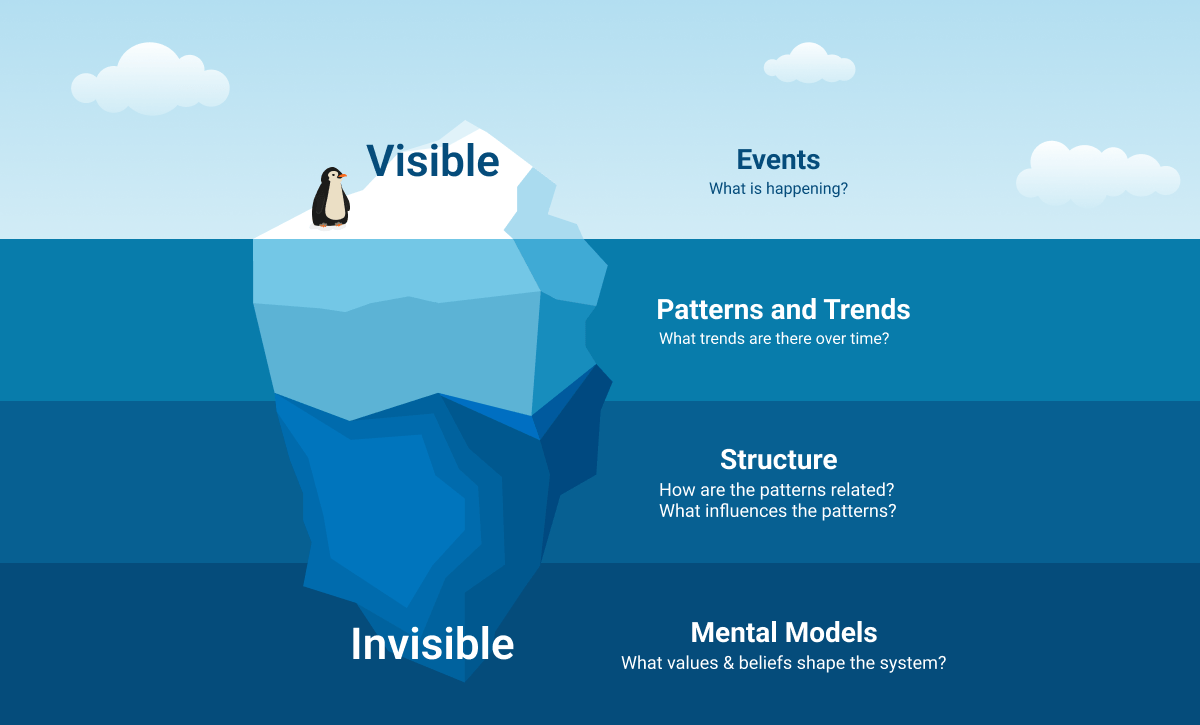
Embarking on the Adventure of Systems Thinking
Hey there, product professionals! Ever feel like you’re embarking on an epic adventure when crafting products? That’s because, in a way, you are! Product design is like navigating through a galaxy of intricate relationships. Each decision made sends ripples through this cosmic web. This shapes our creations in ways that are both obvious and hidden. But fear not! To simplify the complexities of product design, there is a secret weapon. We call this “systems thinking.”

Systems thinking is a way to solve problems and understand the world. We do this by seeing everything as a connected system, not separate parts. It helps us see how different parts interact to affect the whole system. Systems thinking is not a method; it’s a new way of thinking. Join us on this journey into systems thinking. Here, we’ll explore complexity and discover how different pieces shape our decisions.
Uncovering the Depths of Systems Thinking
Systems thinking isn’t about seeing what’s visible. It’s about understanding what lies beneath the surface. A common model that designers reference is the iceberg model. What’s visible above the surface is a fraction of the intricate network below. This model reminds us of hidden structures, patterns, relationships, and feedback loops. These exist within any system. They’re essential yet often unseen, influencing the system’s behavior. To comprehend and address these hidden elements, we must look deeper. By adopting this approach, we unlock the potential to craft more effective solutions for products and systems alike.

Embracing Complexity
What does it mean to simplify product complexity using systems thinking? For designers, it means seeing and appreciating all the moving pieces in a system. Let’s break down some key pieces:
-
How feedback loops change the system:
Imagine you’re in a big traffic jam on the highway. You might wonder how it got so bad, right? Well, that’s where feedback loops come in. They’re kind of like dominoes in a row, where one thing leads to another.
There are two types of feedback loops: positive and negative. Positive feedback amplifies or magnifies the change or output. Like when one car slows down and causes others to slow down too, making the traffic jam worse. It’s like a chain reaction that speeds things up.
But then there’s negative feedback, which is a type of self-regulating system. In our traffic jam example, it’s when drivers slow down enough to keep a safe distance from the car in front. This prevents the jam from getting even more chaotic.
So, feedback loops show us how connected everything in a system is. They help us understand why things happen the way they do and how to keep things running smoothly. Knowing how traffic works helps us avoid getting stuck in jams, and understanding feedback loops helps us keep systems from going haywire.
-
How delays in time affect the system:
In product design, time delays are important because they show how long it takes for different parts of a product to react or respond. They help us understand the time it takes from when you do something to when you see the result. These delays can be quick or slow, and they affect how fast a product responds to changes or commands.
Let’s say you’re using a remote control for your TV. When you press a button to change the channel, there might be a delay before the channel actually changes. This delay can be frustrating, especially if you’re trying to watch something quickly. In product design, similar delays can happen. For example, you press a button on a website, and it takes a moment for the page to load.
These delays can happen for different reasons. For example, slow internet connections or complicated processes happen behind the scenes. And like the remote control example, these delays can impact how the product works. In turn, it impacts how happy people are with using it.
If there are too many delays in a product, it can make people lose interest or get frustrated. But if designers can reduce these delays, it can make the product more enjoyable and easier to use. So, understanding and managing time delays in product design is important for making sure products work well and people like using them. By minimizing delays, designers can create products that respond to what people want, making for a better experience.
-
How emergent properties come from the way things in the system interact:
Emergent properties are like the secret sauce of systems thinking. They’re what happens when individual parts of a system come together and create something unexpected. Let’s take a flock of birds as an example. They might flock together in a way that seems like they’re all on the same page. But in reality, each bird is doing its own thing.
That’s the magic of emergent properties. They show us that when different parts of a system work together, they can create something greater than the sum of their parts. It’s teamwork at its finest, where the whole is greater than the sum of its individual pieces.
By understanding and accepting these complex parts, designers can make better, stronger solutions. Systems thinking enables teams to adapt and refine their products. This helps them create designs that last longer and are more effective in the long run.
The Traffic Light System
Let’s apply systems thinking to your morning commute. As you navigate the streets, you encounter a series of traffic lights guiding the flow of traffic. These lights aren’t random. They’re part of a well-designed system aimed at keeping things running. Each light change triggers a cascade of events. From cars moving to pedestrians crossing the street, it’s all interconnected. If one intersection gets jammed up, it can cause delays elsewhere. That’s why city planners use systems thinking to keep traffic flowing.

Designing a Weather App
Now, let’s apply systems thinking to designing a weather app. At first glance, it might seem simple—show the weather, right? But when we dig deeper, we realize there’s a lot more to it. We need to gather data from satellites, weather stations, and models to ensure accuracy. Plus, we need to think about the user interface, making sure it’s easy for everyone to understand. And let’s not forget about accessibility and performance. These are all crucial factors in creating a successful app.
The Power of Systems Thinking in Product Design
So, it’s time to embrace the power of systems thinking! By looking at the bigger picture, embracing complexity, and approaching challenges with an open mind, we can simplify product complexity. This will shape the future of product design. It’s an exciting journey—one filled with discovery and innovation. So, let’s dive in and explore the endless possibilities that lie ahead!
Let’s build awesome things together.
Our approach to Product Design & UX is holistic, integrating business, tech, user needs, and market demands.